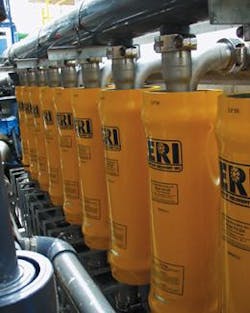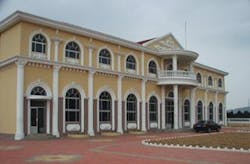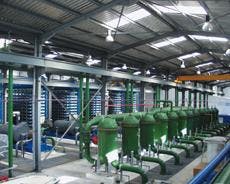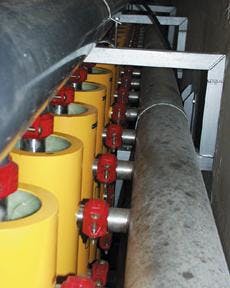By G. G. Pique
PX-220 large-rotor installation in Caramondani SWRO facility in Dhekelia, Cyprus
The innovative Pressure Exchanger ceramic pump reduces energy requirements for reverse osmosis desalination plants by more than 50%, according to Energy Recovery, Inc.
Getting drinking water from the vast, renewable resource of the ocean at an affordable cost for drought-ridden coastal areas used to be a dream - but not any longer, according to Energy Recovery Inc. (ERI), a small company in San Leandro, California, USA. By inventing and developing a new type of high-pressure pump, ERI is rapidly changing the economics of seawater desalination. The company says its advanced ceramic technology reduces by a factor of four the energy wasted in the process of converting seawater into drinking water, thus making it a lot less expensive.
Since energy is the largest cost of operating a desalination plant, pressure exchanger technology is driving an explosion in the demand for desalination plants. According to the reputable German company Wagnick Consultants, the rate at which new seawater reverse osmosis (SWRO) capacity is being added has increased by 140% over the last two years. In the next couple of years, this percentage will rise further leading to a measurable increase in worldwide capacity including every SWRO plant that has been installed. The industry is growing rapidly, mainly for the largest plants.
The facility building at the SWRO plant in Changdao, China
The cost of SWRO has fallen due to advances in membrane technology and energy recovery technology. For example, Mekorot, the Israeli national water company, put out to bid three 100,000 m3/d SWRO build-operate-own and transfer (BOOT) plants and the water price for one plant came back as US$ 0.527 per m3. This cost was far lower than expected, so Mekorot doubled the number of plants that they want from three to six. One reason for this surprisingly low cost is the implementation of pressure exchange-type energy recovery devices.
Backed by a development fund of US$ 9.5 million from a private group of investors, the ERI team recently launched the PX-220, a breakthrough high-flow, 1,000-ton/day pressure exchange ceramic pump for large-scale seawater desalination plants. This device, says ERI, promises to change the way the world looks at the ocean to what can now be seen as an almost infinite source of fresh drinking and irrigation water and as a renewable energy source.
This sounds like a big claim for a San Francisco Bay Area start-up with only sixteen employees. But if ERI's high-tech background is any indication, the closely held company is already at the leading edge of desalination technology and may shortly become a pioneer in the development of new renewable energy sources. The ERI team includes Dr. Rick Stover from University of California at Berkeley as its chief scientist.
The origins of ERI can be traced to Leif Hauge, a Norwegian inventor working in the early 1990s at the Kuwait Institute of Scientific Research (KISR) laboratories. In 1990 when Iraqi forces invaded Kuwait, Saddam' soldiers arrived at the KISR looking for advanced technology; however researchers at the KISR destroyed key documents to prevent their transfer to Baghdad. Instead, Hauge and others were taken as prisoners to Baghdad. Once the war ended, the inventor was repatriated to the USA, where he started ERI.
ERI's technology is an improvement over the well-known method of reverse osmosis, a widely used process in which seawater is pushed at very high pressure through polymer membranes. Part of the water permeates the membranes and leaves all the salt behind. The remaining salty brine contains as much as 185% of the energy required for desalination, and in the past, most of this energy literally went down the drain.
Engineers designing modern seawater desalination plants using reverse osmosis used Pelton Wheels to try to recover this energy. The problem is that the Pelton Wheel is a technology developed in 1850 that never surpassed 80% overall efficiency in its best modern execution using advanced materials and computer designs. In typical operating conditions, Pelton devices are only about 60% efficient.
When he founded ERI, Hauge's idea was to develop a positive displacement pump that would recycle the energy inherently wasted by the reverse osmosis process. This type of pump had the potential to recover brine energy from seawater reverse osmosis plants with an efficiency of over 95%. He tried for three years to make his device out of stainless steel, titanium and other fancy alloys, but the metal parts would gall and seize because seawater is such a poor lubricant.
Hauge continued to tinker in his laboratory and by 1997 he developed several commercial ceramic devices that were saving energy in medium-sized desalination plants in the Canary Islands. Five US patents were granted along and by late 1999 dozens of these small ceramic pumps were saving energy in small and medium desalination plants worldwide. Some of these devices have been operating for more than five years with no maintenance. By late 2002, almost 500 ERI ceramic devices were installed in existing desalination plants.
Plant view of the Caramondani Desalination Plants Ltd. facility in Dhekelia, Cyprus.
A much bigger ceramic device was required as plant efficiency increased and larger desalination plants were being built. ERI is now shipping in quantity the PX-220, a large-diameter ceramic pump capable of handling the needs of a 1,000-ton per day desalination plant (250,000 gallons per day) in a single unit. These ceramic devices, called Pressure Exchangers, are arrayed in parallel to work in large installations.
The new large rotor device is installed only in two facilities: the SWRO plant owned and operated by Vivendi Enerserve in St. Maarten; and the SWRO at Dhekelia, Cyprus, owned and operated by Caramondani Desalination Plants, Ltd. The train size of the SWRO Caramondani plant is 10,000 m3/d. The plant is being converted from eight 5,000 m3/d trains to four 10,000 m3/d trains. Caramondani has one 10,000 m3/d train equipped with twenty older, smaller ERI PX-120s, one 10,000 m3/d train equipped with ten of the newer, larger PX-220s and is in the process of installing another ten PX-220s. The PX-220 has also been shipped to Hydropro, Inc. in Lake Park, Florida, USA and to a customer in China.
How it works
The Pressure Exchanger ceramic pump takes energy from high-pressure brine and recycles it to incoming seawater at over 95% efficiency, which reduces energy requirements to less than 50% of the amount prevalent a few years ago. According to John MacHarg, general manager of ERI: "Imagine that you invented a 200-horsepower ceramic engine weighing 110 pounds. It's as if you could replace the clunky engine in your car with a new ceramic one and now your car can travel at normal speeds and get 90 miles per gallon of gas. Finally, because this is ceramic technology, there would be virtually no maintenance and you could expect to go 1.5 million miles between engine checkups.
"That, in proportion, is what ERI's Pressure Exchanger is doing to the desalination industry. With this technology you can now produce pure desalinated seawater less expensively than by pumping silty water, full of fertilisers and pesticides, over the mountains from the Colorado River (USA). As a result, the demand for desalination plants is growing at over 30% per year. Desalinated seawater is now so cheap that it is being used in Spain and Israel for agriculture." Several reasons for this low price include pressure exchanger technology, membrane technology, inexpensive land and cheap, subsidised power costs (e.g. US$ 0.04/kWh).
Osmotic power plants
The ERI pumps are also being designed into osmotic power plant installations now in the planning stage. Osmotic power uses osmosis instead of reverse osmosis. Basically, the process is reverse osmosis in reverse and the high-pressure pump is replaced by a turbine and generator. These osmotic power plants use the salinity gradient between the ocean or similar salty bodies of water such as the Great Salt Lake, Salton Sea or Dead Sea and a fresh water source such as a river or underground aquifer in a forward-flowing version of reverse osmosis. The process simply does not work without the ERI Pressure Exchanger or similar pump. A 50-megawatt demonstration plant will require 1,000 of 1,000-ton/day ERI devices, so the company is working on developing a bigger and better 2,000-ton/day ceramic pump.
Author's noteG.G. Pique is the president and chief executive officer of Energy Recovery, Inc., based in San Leandro, California, USA.






